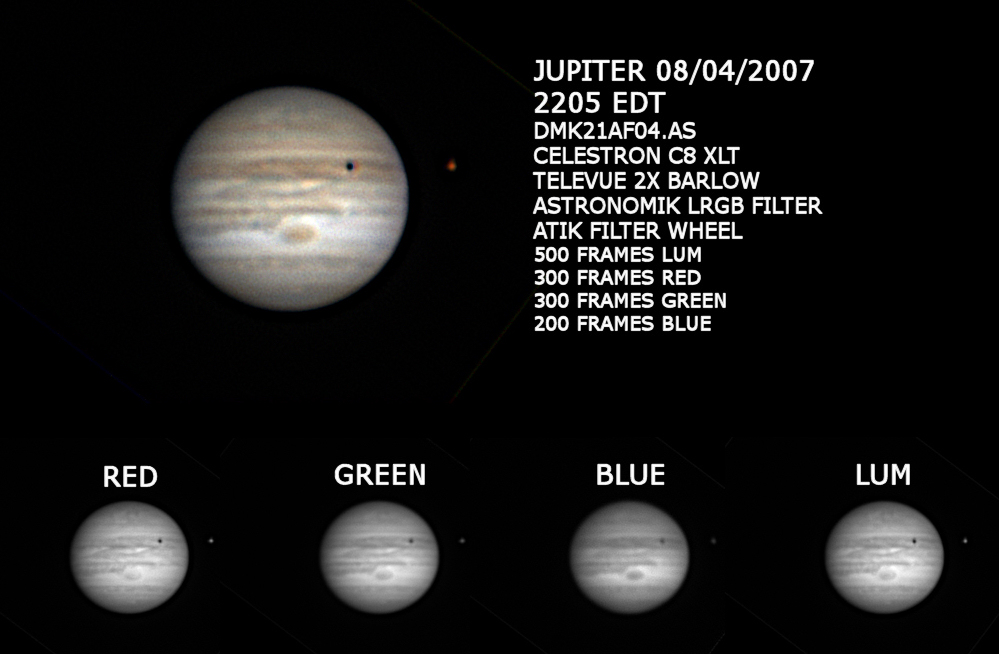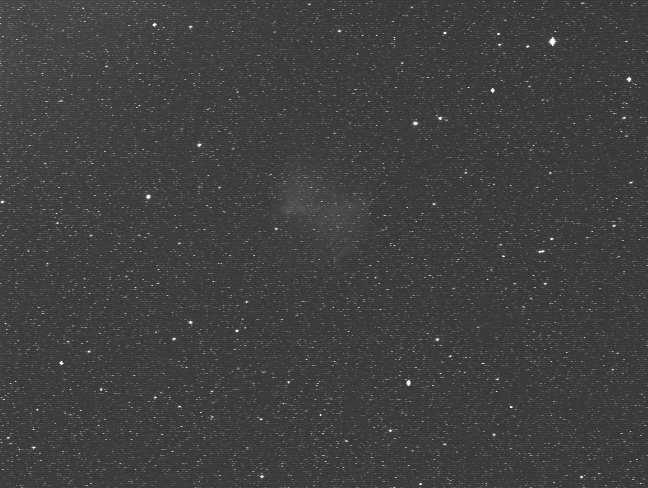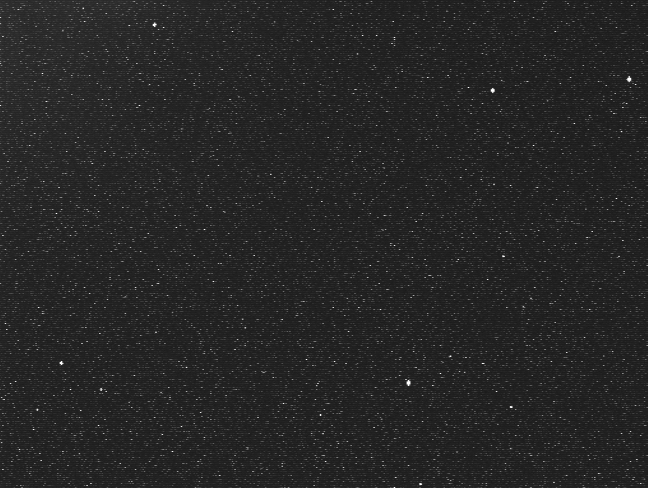Saturday night I set up the camera again, this time pointing more towards the northern part of the sky. Exposures were set to 16 seconds with a bit higher gain than before. You'll notice the top of the chimney flashing in the lower left corner. That's my neighbor's motion-detecting light coming on every time a car passes by on the road in front. One of the lights on his front corner points straight back into my backyard - very annoying!
Anyway, I think I caught one meteor - pretty disappointing.
Sunday, August 12, 2007
Saturday, August 11, 2007
One night in about a minute
I've been thinking about building an all-sky camera for a while now. It's not something I really need but it seems like a fun project. I recently received a small optical dome from Surplus Shed. I don't know what camera I will end up using for the final version. Last night I set my DMK21AF04.AS camera up on a tripod with a Fujinon 2.8mm lens attached. I taped a Baader UV/IR filter on front of the lens and pointed the camera straight up. The exposures were set to about 20 seconds each with the gain set fairly low to reduce noise. I let it run from 10PM to 6AM and used the Y800 mode for recording the video in IC Capture. The video starts with Vega shining brightly just above left of center, and ends with the Pegasus moving off to the right as the Pleiades and Mars approach on the left before dawn. I was hoping to catch a few Perseids but I think I only caught air traffic going by. Here's the result, converted to 15 frames per second:
I will eventually get a wider angle lens since the 2.8mm Fujinon only has about a 90-degree field of view. There's a more expensive varifocal lens that covers nearly 180 degrees. A little more saving will be required before I get that lens. But then my birthday is coming soon!
I will eventually get a wider angle lens since the 2.8mm Fujinon only has about a 90-degree field of view. There's a more expensive varifocal lens that covers nearly 180 degrees. A little more saving will be required before I get that lens. But then my birthday is coming soon!
Monday, August 6, 2007
My first Jupiter in LRGB with the DMK21AF04.AS
My new Astronomik LRGB filters came in last Friday and I was just itchin' to try them out. Saturday night seemed like my best opportunity in a long time - the skies were about as clear as it's gonna get in summer. In other words, hazy and humid. The seeing was just OK but that wasn't going to stop me.
I had a couple of other new "toys" - the Atik manual filter wheel and a Televue 2X barlow. I also picked up a C-mount to T-thread adapter to mount my DMK21AF04.AS camera to the male T-threads of the filter wheel. The other side of the filter wheel uses a T-thread to 1.25" nosepiece adapter.
I started out by slewing to a medium brightness star and checking focus using Metaguide. I've used Metaguide a lot for autoguiding, but one feature I really like is the FWHM measurement. That gives me a quick way of dialing in the right focus without messing around with a mask or any other focusing aids.
Once centered on Jupiter I fired up IC Capture and adjusted for the right exposure. I should have taken some screen shots here, but what I did was open up the histogram and adjust the exposure & gain settings to get the maximum spread of the histogram with each filter. The luminance filter required a shorter exposure and less gain while the color filters needed longer exposures. The blue filter took the longest exposure and as expected, due to atmospheric turbulence, it produced the worst quality image. The atmosphere affect the longer wavelengths more than the red (shorter) wavelengths. I only took no more than one minute of each color and luminance at 15 fps. Jupiter rotates very fast, so you must move quick. I was pleasantly surprised to find Io transiting across Jupiter's disk when I got started. The moon Io is similar in size to our own moon. I took a couple of quick LRGB sequences and worked on the results in Registax. The resulting images were saved in TIFF format, then some minor adjustments were made in Photoshop. I then used ImagesPlus to align the images and combine as a LRGB image. Here's the result which also shows the separate channels:

I am very happy with the result, especially since I really don't know what I am doing with Registax, and have only been at this for less than one year. I still have a lot to learn but I am enjoying it and taking things slowly.
After taking some AVI's with the DMK camera, I decided to pop in the SPC900NC webcam before Io was gone to make a quick comparison. I took a few one-minute videos and tried my best to squeeze out some detail in Registax. This is the best I could get, and it's definitely not even close to the quality of the DMK:

Now I need to find a good home for the SPC900NC. It doesn't look like it will see much use anymore.
I had a couple of other new "toys" - the Atik manual filter wheel and a Televue 2X barlow. I also picked up a C-mount to T-thread adapter to mount my DMK21AF04.AS camera to the male T-threads of the filter wheel. The other side of the filter wheel uses a T-thread to 1.25" nosepiece adapter.
I started out by slewing to a medium brightness star and checking focus using Metaguide. I've used Metaguide a lot for autoguiding, but one feature I really like is the FWHM measurement. That gives me a quick way of dialing in the right focus without messing around with a mask or any other focusing aids.
Once centered on Jupiter I fired up IC Capture and adjusted for the right exposure. I should have taken some screen shots here, but what I did was open up the histogram and adjust the exposure & gain settings to get the maximum spread of the histogram with each filter. The luminance filter required a shorter exposure and less gain while the color filters needed longer exposures. The blue filter took the longest exposure and as expected, due to atmospheric turbulence, it produced the worst quality image. The atmosphere affect the longer wavelengths more than the red (shorter) wavelengths. I only took no more than one minute of each color and luminance at 15 fps. Jupiter rotates very fast, so you must move quick. I was pleasantly surprised to find Io transiting across Jupiter's disk when I got started. The moon Io is similar in size to our own moon. I took a couple of quick LRGB sequences and worked on the results in Registax. The resulting images were saved in TIFF format, then some minor adjustments were made in Photoshop. I then used ImagesPlus to align the images and combine as a LRGB image. Here's the result which also shows the separate channels:

I am very happy with the result, especially since I really don't know what I am doing with Registax, and have only been at this for less than one year. I still have a lot to learn but I am enjoying it and taking things slowly.
After taking some AVI's with the DMK camera, I decided to pop in the SPC900NC webcam before Io was gone to make a quick comparison. I took a few one-minute videos and tried my best to squeeze out some detail in Registax. This is the best I could get, and it's definitely not even close to the quality of the DMK:

Now I need to find a good home for the SPC900NC. It doesn't look like it will see much use anymore.
Sunday, August 5, 2007
First light with the DSI Pro
Saturday night I headed out for a quick test of my new Meade DSI Pro. The weather finally cooperated on a weekend - first time in 3 months. Even after 10PM it was still pretty hot outside, and I had to wear long pants and a long-sleeved flannel shirt to keep the mosquito bites to a minimum. I was sweating, uncomfortable, and busy swatting the skeeters away from my face & ears, but I managed to capture a quick set of images. After taking a few test shots to tweak the focus, I set the long exposure mode to 60 seconds and let the software take it from there. Looking at the individual frames was not that impressive, but there was something there. Here's a single 60-second image of M27 - the Dumbbell Nebula:

I chose the option to save all raw images to FITS format. Since the DSI Pro has non-square pixels, the raw format file actually comes out "squished" horizontally to 508 pixels wide instead of the full format of 648 pixels wide. When using Envisage to do all the combining it automatically corrects the image scale. I am comfortable with ImagesPlus, so I just transformed the horizontal dimension in IP after alignment and stacking. I also took a few dark frames - here's one 60-second dark frame at around 80 degrees:

Having only 20 exposures I wasn't expecting much, especially after seeing the noisy single frames. But I was pleasantly surprised after a median combine and a quick DDP adjustment in ImagesPlus. The outer faint details in M27 were clearly evident in the resulting image. Next time I will try with my new LRGB filters. Overall I am very impressed with the DSI Pro and looking forward to much more imaging, weather permitting. Here's my result of 20 exposures at 60 seconds each:


I chose the option to save all raw images to FITS format. Since the DSI Pro has non-square pixels, the raw format file actually comes out "squished" horizontally to 508 pixels wide instead of the full format of 648 pixels wide. When using Envisage to do all the combining it automatically corrects the image scale. I am comfortable with ImagesPlus, so I just transformed the horizontal dimension in IP after alignment and stacking. I also took a few dark frames - here's one 60-second dark frame at around 80 degrees:

Having only 20 exposures I wasn't expecting much, especially after seeing the noisy single frames. But I was pleasantly surprised after a median combine and a quick DDP adjustment in ImagesPlus. The outer faint details in M27 were clearly evident in the resulting image. Next time I will try with my new LRGB filters. Overall I am very impressed with the DSI Pro and looking forward to much more imaging, weather permitting. Here's my result of 20 exposures at 60 seconds each:

Subscribe to:
Posts (Atom)